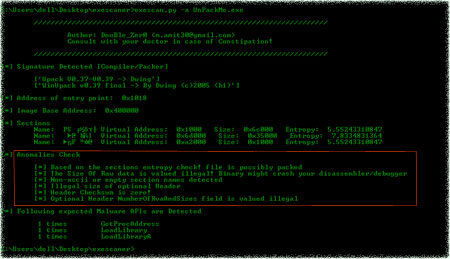About ExeScan
ExeScan is the FREE console based tool to detect anomalies in PE (Portable Executable) files. It quickly scans givenexecutable file and detect all kind of anomalies in its PE header fields including checksum verifications, size of various header fields, improper size of raw data, non-ascii/empty section names etc.
Various packers/protectors modify PE header to make reversing harder. Sometimes anomalies in PE header may crash Debugging tools thereby blocking your attempt to reversing. Such anomalies can also make some of the GUI based PE analysis tools to fail to parse PE headers.
In such cases ExeScan can come handy by helping you to quickly detect such anomalies. Then you can fix them and proceed to further analysis of malware.
In addition to finding various anomalies, it can also detect packer/compiler used to pack/build the target executable file. Beingconsole based tool, you can easily integrate it with your malware automation suite.
Various packers/protectors modify PE header to make reversing harder. Sometimes anomalies in PE header may crash Debugging tools thereby blocking your attempt to reversing. Such anomalies can also make some of the GUI based PE analysis tools to fail to parse PE headers.
In such cases ExeScan can come handy by helping you to quickly detect such anomalies. Then you can fix them and proceed to further analysis of malware.
In addition to finding various anomalies, it can also detect packer/compiler used to pack/build the target executable file. Beingconsole based tool, you can easily integrate it with your malware automation suite.
Features of ExeScan
| Here are the main feature highlights |
|

